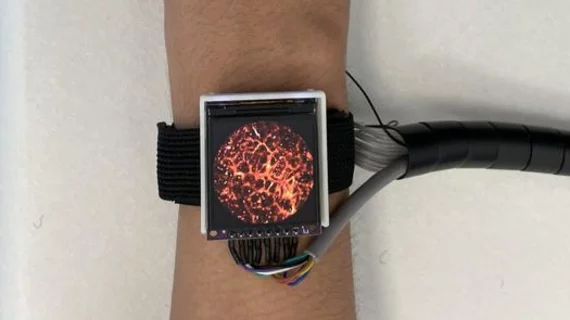Researchers develop small, wearable photoacoustic imaging system
Forget about the heart monitor on your Apple Watch, checking your vital signs is rudimentary compared to what this watch can do: Researchers in China have developed a wristwatch that not only accurately monitors hemodynamic indicators such as heart rate, blood pressure and oxygen saturation, it also produces high-resolution images of blood vessels using photoacoustics, allowing the wearer to literally see how well their blood is flowing.
“Although photoacoustic imaging is extremely sensitive to variations in hemodynamics, difficulties in miniaturizing and optimizing the imaging interface have limited the development of wearable photoacoustic devices,” research team leader Lei Xi, PhD, from Southern University of Science and Technology in China, said in a statement. “To the best of our knowledge, this is the first photoacoustic wearable device that is suitable for healthcare applications.”
To call this a “wristwatch” is a little misleading. More accurately, it’s a portable photoacoustic imaging system that fits in a backpack, as a small computer, laser and power supply are all necessary to operate the imaging interface contained in the watch.
All the same, at 7 kilograms, it’s light enough to be used anywhere. Test trials were able to observe the blood flow of wearers during light activity, such as taking a walk, and the imaging system was shown to allow for unrestricted movement while remaining functional and stable. The findings from the tests are published in the journal Optics Letters. [1]
“Miniaturized wearable imaging systems like the one we developed could potentially be used by community health centers for preliminary disease diagnosis or for long-term monitoring of parameters related to blood circulation within a hospital setting, offering valuable insights to inform treatments for various diseases,” Xi said. “With further development this type of system could also be helpful for the early detection of skin conditions such as psoriasis and melanoma or for analyzing burns.”
A complete imaging system wearable
Photoaccoustic imaging is still a relatively new modality primarily used in research. However, as the development of the watch-and-backpack system demonstrates, researchers are beginning to explore its clinical applications. In this case, an entire photoacoustic imaging system is small enough to be taken home by a patient in need of cardiovascular monitoring.
The compact system utilizes a pulsed laser, tight fiber-based light path and integrated electronics, with the handheld computer used for image storage. The watch interface is a sophisticated scanner, complete with adjustable focal plane and real-time image display. Designed for imaging while in motion, the system features adaptable laser focus crucial for multilayered structure imaging, achieving a lateral resolution of 8.7 µm sufficient for viewing microvessels in the skin, along with a 3 mm field of view, suitable for capturing microvascular details.
The researchers conducted tests on a wearable device with volunteers to assess its ability to detect changes in blood flow while the wearer is engaged in various activities, such as walking and temporarily restricting blood flow with a cuff.
Future improvements are aiming to make the system stable in more intense conditions, such as when the wearer is running, hiking, or jumping. The researchers said they also want to integrate multispectral illumination, capable of measuring vessel volume. This would facilitate quantitative assessment of parameters like vessel number and volume, potentially aiding in the early diagnosis of conditions such as cancer and cardiovascular disease.
Xi said his team is also looking to make the imaging system even more compact with some refinements, including a smaller laser source with higher repetition rates, along with more efficient image storage.
“Given the rapid development of modern laser diode technology and electronic information technology, it should be entirely feasible to develop a more advanced and intelligent photoacoustic watch that doesn’t require a backpack,” Xi added.
You can read the full paper on the photoacoustic watch here.

